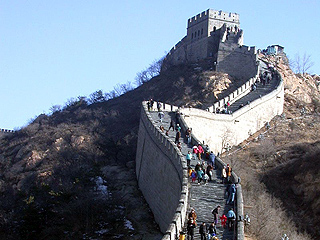 |
| The Badaling section of the Great Wall snaking along the mountains northwest of Beijing. (Picture: ChinaVista) |
One of the most famous defence lines from ancient history is the Great Wall of China. This is the largest man-made construction on Earth, with a length of 2,500 kilometres, a height of 16 metres and a width of 5 metres.
Another example of an old defence line is Hadrian's Wall in the northern part of England. This wall was built between 117 and 138 AC during the reign of Emperor Hadrianus. Around this time the Romans also built a defence line in Germany, south of Bonn.
Generally, it was mainly the more important cities were protected from attackers by a surrounding wall. Only in the 19th century do we see the return of great national defence lines.
Several national keeps existed in Europe but the one around Amsterdam was with 149 km longer than those of Boekarest (90 km), Antwerp (105 km) and Paris (130 km).
The initiative for the line known as the Maginot Line in France was taken when André Maginot was in power as Minister of War. The construction started in 1929 and lasted until 1940. The Maginot Line ran from Dunkirk, north of Verdun and Metz (this was the strongest point) via Strassbourg to the Swiss border. The line had to be capable of resisting the German threat. In reply, the Germans constructed the >Westwall in West Germany.
|
|
| Ouvrage de Rimplas; Battery near the village Rimplas in de Alps-sector of the Maginot Line. (From: La Muraille de France) |
The tank barriers of the Westwall near the village of Schmithof, southeast of Aachen. (Picture: René Ros, 1998) |
The purpose of the Atlantikwall (1942-1944) was to prevent landings along the German occupied coast. The Germans used standard designs for their bunkers from Norway to France. In the Netherlands, existing coastal defence works were occupied by the Germans and enlarged. The Fort near IJmuiden, in the North Sea Canal, was also occupied and enlarged by the Germans.
